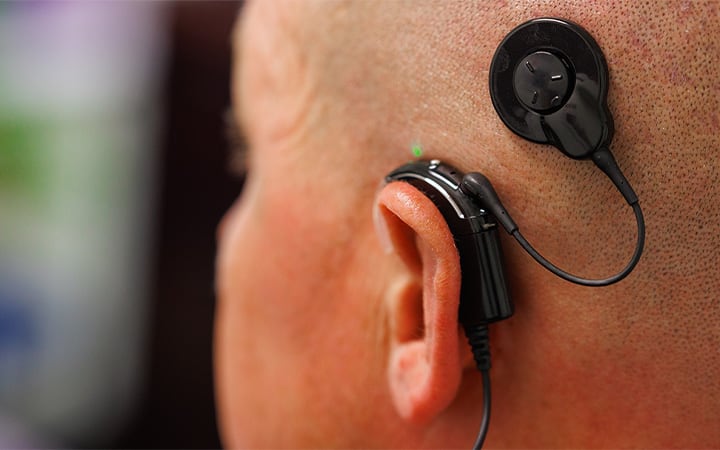Next-Generation Cochlear Implants Protect Natural Hearing
October 09, 2025

It used to be that cochlear implants were only for people with the most severe hearing loss. In those patients, the benefits outweighed the loss of any residual hearing caused by surgery.
“But now, with our ability to improve sound clarity while also protecting residual hearing, cochlear implants are an option for patients with moderate hearing loss,” says Alejandro Rivas, MD, Division Chief of Otology and Neurotology, Director of the Cochlear Implant Center at University Hospitals Ear, Nose & Throat Institute. “These patients include younger, working-age adults who may not realize they are candidates.”
How Cochlear Implants Work
Cochlear implants work differently from hearing aids. While hearing aids amplify sound, cochlear implants replace the function of a damaged cochlea, which is the snail-shaped organ in the inner ear that helps you hear.
Cochlear implants have external and internal parts:
- External: A sound processor worn on or near the ear detects sounds with a microphone, turns them into electrical signals and sends the signals to the implant inside the ear.
- Internal: A receiver is implanted under the skin behind the ear and a thin wire with tiny electrodes is placed inside the cochlea. The receiver sends signals from the sound processor to the cochlear nerve, which the brain understands as sound.
New Advances in Treatment
Atraumatic cochlear implantation surgery – surgery that minimizes harm to the cochlea – includes improving the precision of the surgery, reducing the force used to place the implant, reducing the size of the implant and using steroids to reduce inflammation.
- Robotic Surgery: University Hospitals uses a robotic-assisted system that places electrodes in the cochlea with high precision. The system uses less force than traditional surgery, which helps protect residual hearing by minimizing harm to the cochlea.
- Slimmer Implants: Dr. Rivas and his colleagues participated in a recent study that uses a cochlear implant with a slimmer design.
- Steroid Treatment: The slimmer implant includes a wire that releases a steroid to reduce inflammation in the ear.
“Typically, we can preserve 60 to 70 of a patient’s natural hearing with atraumatic surgery,” says Dr. Rivas. “The study showed that we can now preserve up to 90 percent of a patient’s natural hearing when using a slim implant and a steroid to reduce inflammation.”
Future Developments
Many elderly people who could significantly benefit from cochlear implants don’t get them because of the risks of surgery and general anesthesia. University Hospitals is testing the use of local anesthesia in cochlear implant surgery for older patients. Local anesthesia numbs a specific area of the body without putting the patient fully to sleep.
Dr. Rivas is also excited to participate in a clinical trial evaluating a fully implantable cochlear implant. Potential benefits include:
- Eliminating the need to clean and maintain an external component.
- Reducing unwanted noise picked up by external microphones.
- Making daily activities like bathing and swimming easier.
- Minimizing self-esteem and confidence issues caused by a visible cochlear implant.
Related Links
University Hospitals Cochlear Implant Center of Excellence+ is among the top 10 programs in the nation for the total number of cochlear implants performed each year. The center continues to offer an unprecedented level of expertise and innovation in auditory research and hearing preservation.


